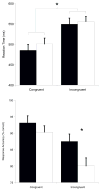The effect of acute treadmill walking on cognitive control and academic achievement in preadolescent children
- PMID: 19356688
- PMCID: PMC2667807
- DOI: 10.1016/j.neuroscience.2009.01.057
The effect of acute treadmill walking on cognitive control and academic achievement in preadolescent children
Abstract
The effect of an acute bout of moderate treadmill walking on behavioral and neuroelectric indexes of the cognitive control of attention and applied aspects of cognition involved in school-based academic performance were assessed. A within-subjects design included 20 preadolescent participants (age=9.5+/-0.5 years; eight female) to assess exercise-induced changes in performance during a modified flanker task and the Wide Range Achievement Test 3. The resting session consisted of cognitive testing followed by a cardiorespiratory fitness assessment to determine aerobic fitness. The exercise session consisted of 20 min of walking on a motor-driven treadmill at 60% of estimated maximum heart rate followed by cognitive testing once heart rate returned to within 10% of pre-exercise levels. Results indicated an improvement in response accuracy, larger P3 amplitude, and better performance on the academic achievement test following aerobic exercise relative to the resting session. Collectively, these findings indicate that single, acute bouts of moderately-intense aerobic exercise (i.e. walking) may improve the cognitive control of attention in preadolescent children, and further support the use of moderate acute exercise as a contributing factor for increasing attention and academic performance. These data suggest that single bouts of exercise affect specific underlying processes that support cognitive health and may be necessary for effective functioning across the lifespan.
Figures




References
-
- American College of Sports Medicine. ACSM’s guidelines for exercise testing and prescription. 7. New York: Lippincott Williams Wilkins; 2006. - PubMed
-
- Angevaren M, Aufdemkampe G, Verhaar HJJ, Aleman A, Vanhees L. The Cochrane Collaboration. West Sussex: Wiley & Sons; 2008. Physical activity and enhanced fitness to improve cognitive function in older people without known cognitive impairment (Review) pp. 1–98. - PubMed
-
- Ansari D, Dhital B. Age-related changes in the activation of the intraparietal sulcus during nonsymbolic magnitude processing: an event-related functional magnetic resonance imaging study. J Cogn Neurosci. 2006;18:1820–1828. - PubMed
-
- Brezun JM, Daszuta A. Serotonin may stimulate granule cell proliferation in the adult hippocampus, as observed in rats grafted with foetal raphe neurons. Eur J Neurosci. 2000;12:391–6. - PubMed
-
- Birnbaum AS, Lytle LA, Murray DM, Story M, Perry CL, Boutelle KN. Survey development for assessing correlates of young adolescents’ eating. Am J Health Behav. 2002;26:284–295. - PubMed

